December 1, 2017
Kavli Institute for the Physics and Mathematics of the Universe (Kavli IPMU)
To celebrate 10 years since the establishment of the Kavli Institute for the Physics and Mathematics of the Universe (Kavli IPMU), the institute hosted a 10th Anniversary Ceremony inside the Kavli IPMU building on Kashiwa Campus on 16 October.
Around 230 people, including distinguished guests, researchers, and many of those who have been or currently are involved with the Kavli IPMU watched over the ceremony. Congratulatory speeches were given by several distinguished guests, including University of Tokyo President Makoto Gonokami, Institute for Solid State Physics Director, and Representative of Kashiwa Campus Masashi Takigawa, Nobel laureate David Gross, Fields medalist Shing-Tung Yau, Ministry of Education, Culture, Sports, Science and Technology Research Promotion Bureau Director-General Seki Yasunao, Kashiwa City Mayor Hiroyasu Akiyama, WPI Program Director Akira Ukawa, Kavli IPMU External Advisory Committee Chair Steven Kahn, and Kavli Foundation President Robert W. Conn.
Other highlights from the ceremony include the first viewing of the Kavli IPMU 10 year history video, video messages from other Kavli instates from around the world, and special speeches Professor Mikhail Kapranov and Project Assistant Professor Thomas Melia who spoke on behalf of the Kavli IPMU researchers, and lastly by Kavli IPMU Director Hitoshi Murayama.
In addition to the anniversary ceremony, the institute also hosted a three-day 10th Anniversary Symposium at the Kashiwanoha Conference Center, which overall was attended by more than 500 researchers and students.
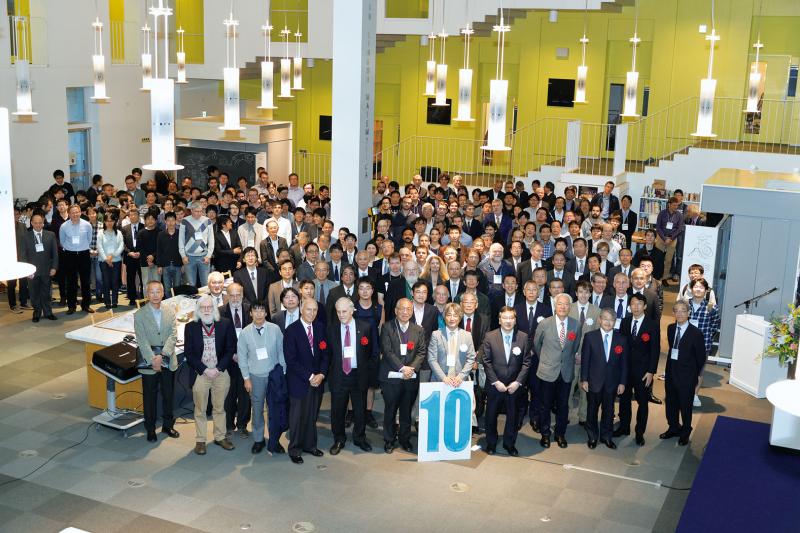
Related Links
- 10th Anniversary Symposium Program, slides and further information
- All remarks for Kavli IPMU 10th Anniversary
Remarks by Makoto Gonokami, President of the University of Tokyo
Good afternoon, distinguished guests, Ladies and Gentlemen.
On behalf of the University of Tokyo, the host institute of the Kavli IPMU, I would like to say a few words.
First of all, I am very happy to attend this 10th anniversary celebration of the Kavli IPMU. I would like to thank everyone who have come to join us in these celebrations.
When IPMU was proposed as a WPI in 2006, I was in a special position to support President Komiyama and I learned about the plan from Professor Murayama. There were two major goals: One was to solve the mystery of the universe. The other was to introduce a truly international environment in our university. The proposal was very exciting, but, to be honest, I thought the goals were too ambitious.
I am a physicist too. So, I know it is almost impossible for basic research to produce major results according to a fixed plan in a limited period. I also thought that creating a truly international environment was not easy.
In 2007, I was invited to be a member of IPMU’s External Advisory Committee. And, in April 2015, I took office as President of the University of Tokyo. Through these years, I have watched IPMU become a truly international institute. I am very impressed by how the Kavli IPMU managed to achieve so much. It has recruited top-level scientists from around the world. Half of its members are international. And, thanks to the Kavli Foundation, it attracted a major international donation. It became the first Kavli institute in Japan.
As President, I would like to praise their effort to build a truly international research institute that is highly competitive in the world.
Now, it has achieved international recognition as a top-class research institute. In its 10 years of history, more than 60% of the papers published by Kavli IPMU researchers were based on international collaborations. Every year, more than 600 people apply for jobs at Kavli IPMU, and about 500 international visitors come here. More than 40% of its past postdocs are on faculty positions in many institutes around the world. In terms of highly cited papers, it competes well with world leading institutes, such as the Institute for Advanced Study in Princeton. This shows how internationally competitive the Kavli IPMU has become.
Indeed, it has had a great impact on our University, in terms of not only academic activity, but also strengthening our research environment. We gave special treatment to the Kavli IPMU to encourage them to introduce system reforms to become more competitive. Many of the new systems that the Kavli IPMU introduced have now become a part of our University-wide systems.
I really appreciate Professor Murayama for his great effort in achieving all of this. When I met Professor Murayama in 2006, I was struck by his vision and his energy. He was very young. He was 43. And he was different from other people. He had a charisma that made people take a second look. He attracted many young and excellent researchers. He was very persuasive. He was able to introduce new systems to make our University even stronger. People admired his public lectures very much. He brought in huge support from the public.
The Kavli IPMU truly made a difference, and I am convinced that it will continue to do so in the future. As President of the University, I will do everything I can to support the Kavli IPMU.
Last year, we were very pleased that the MEXT approved a five-year extension of the funding for the Kavli IPMU. Last month, we were also very excited to learn that MEXT accepted our new WPI proposal to launch the International Research Center for Neurointelligence (IRCN). IRCN sets an ambitious goal of understanding human intelligence. The team will include our world-leading researchers from medicine, biology and AI. Importantly, we also aim to combine it with the humanities and social sciences, and this will make IRCN truly unique. IRCN will cover a broad range of academic disciplines. In the application process, I also gave a presentation at the panel hearing. I emphasized that the Kavli IPMU is a great success and we can use their knowhow to quickly establish the IRCN. And I felt that this was very persuasive.I hope that there will be active academic collaboration between the Kavli IPMU and IRCN. I also I hope that the two institutes will work closely together to drive the internationalization of the whole of the University of Tokyo.
The University of Tokyo’s mission is to contribute to humanity by creating new value through excellent research and education. Basic science is the foundation of the value that we create. I am pleased that the Kavli IPMU has become a world-leading research institute.
We have many things to learn from its success. I believe that by using these experiences, we can further strengthen the research and education of the University of Tokyo.
Thank you, and congratulations again on the 10th anniversary of the Kavli IPMU!
Remarks by Masashi Takigawa, Director, Institute for Solid State Physics, representing the Kashiwa Campus
(Masashi Takigawa is from the Institute for Solid State Physics located next to the Kavli IPMU, and he chairs the Joint Academic Management Council of the Kashiwa Campus of the University of Tokyo.) Professor Murayama, distinguished researchers of the Kavli Institute for the Physics and Mathematics of the Universe, ladies and gentlemen, on behalf of the Kashiwa campus of the University of Tokyo, I would like to express my hearty congratulations on the occasion of the 10th anniversary of the Kavli IPMU.
The Kashiwa campus is one of the three main campuses of the University of Tokyo and is the youngest one, which started in 2000. Since then, cutting edge research in various fields of science has been actively pursued by several research institutes, as well as the Graduate School of Frontier Sciences. Therefore, all of us were very excited ten years ago when IPMU was born in Kashiwa as a World Premier International Research Center designated by the Japanese government. It is needless to say that outstanding research of IPMU based on the unique integration of Physics, Mathematics and Astronomy to solve fundamental problems of the universe has enormously enhanced the scientific diversity and reputation of the University and the Kashiwa Campus. In addition, I would like to emphasize that the researchers of IPMU from all over the world brought international atmosphere and cultural diversity to the campus. A large fraction of the researchers of IPMU including external visitors are from outside Japan. I appreciate that their presence and interaction with people of the campus has provided rich and stimulating environment.
Let me also mention that our institute ISSP, the Institute for Solid State Physics located next to the IPMU building, has been enjoying very fruitful interaction with IPMU. The target of our research, which includes various novel materials often with structures of nano-meter scale, is very different from the universe, the target of particle and astrophysics. Nevertheless, both fields are based on common principles of physics and it often happens that an idea developed in one field turns out to be very useful in the other field. In fact, IPMU and ISSP have hosted several workshops jointly in the past and we saw some excellent papers came out from cross-disciplinary collaboration between IPMU and ISSP. Such kind of collaboration is truly fruitful and I hope it will be stronger and more extensive in future.
Once again, I would express my sincere congratulations for the remarkable scientific achievements of IPMU in the last decade and wish all the members of IPMU an even more successful future. Thank you very much for your attention.
Remarks by Robert W. Conn, President and CEO, the Kavli Foundation
I’d like to begin by thanking President Gonokami, Mayor Akiyama, the various members of the government ministry MEXT – particularly Dr. Seki and Dr. Ukawa – and the distinguished people here today. As importantly, I’d like to express thanks and congratulate the Japanese government for its conception of the absolutely unique idea of the World Premier International Research Center Initiative, known as WPI. We have many science institutes in the United States funded by our government agency, the National Science Foundation. But the notion of establishing top-tiered research institutes that bring researchers from around the world, use English as the lingua franca of communication among the scientists in the institutes, and doing this in Japan ... well, this is very distinctive and special.
You – the Japanese Government and people – have been innovative and imaginative, and you have put something together of very large scale. When I look at what you are attempting to achieve by way of globalized scientific activity – both projecting science out of Japan, as well as bringing scientists and science to Japan – this is a remarkable thing, and not something I’ve seen anywhere else in the world. So, for all of this, I congratulate the Japanese government, the University of Tokyo and its people, Hitoshi Murayama, the director of the Kavli IPMU, the Institute’s leadership team, and all the members of the Kavli IPMU.
The Kavli Foundation became very aware of IPMU when we began thinking about our next generation of Kavli Institutes. As David Gross pointed out, the Kavli Institute for Theoretical Physics at UC Santa Barbara, where he served as director for many years, was announced as KITP in 2002, and it became the first Kavli institute. Over the next seven years, The Kavli Foundation established and funded 14 more Kavli Institutes.
During the Great Recession that began in 2008 and extended well into 2010, we stopped our large programs and began thinking about what we would do next once things recovered. And when that opportunity arrived, we began to look at where in the world the best work is being done in the science fields that we provide support. At The Kavli Foundation, we support basic research in four areas: astrophysics and cosmology, nanoscience, neuroscience, and theoretical physics. We do so by providing funding whose use is unconstrained. So, when we looked around the globe at what was being achieved, one place that stood out was here, at the University of Tokyo, and what you were attempting to do with the IPMU.
Today, we are celebrating the 10th anniversary of the IPMU, and the 5th anniversary of the Kavli IPMU. With that in mind, I want to point out the portrait of Fred Kavli on the back wall of this room. There are only five of these portraits, each distinct. There’s another at the Norwegian Academy of Science and Letters in Oslo, Norway, the country where Fred Kavli was born. A third portrait hangs outside the Fred Kavli Auditorium at the U.S. National Academy of Sciences in Washington, D.C. There’s a fourth hanging at the Kavli Royal Society International Centre in the U.K., and the Foundation has the fifth and last portrait. So it is wonderful to see Fred’s portrait here, especially in this room and during this very special celebration.
Fred Kavli was an extraordinary person with an extraordinary vision. He liked to say he was a physicist by training, and he was; but he was also an engineer, and a very inventive one at that. He was also a remarkable businessman and entrepreneur who created a great fortune.
When he thought about what to do with his wealth, Fred Kavli decided to give it all back in support of basic science. People like David Gross, here today, and many others had a large influence on Fred as he thought about what to do. In 2000, he began the Foundation with $100–150 million. That is a lot of money but modest by philanthropic standards in the United States. Now, that sum is more than $600 million, no longer modest by any standard, and all of it is from Fred Kavli. He gave it all The Kavli Foundation for support of basic science.
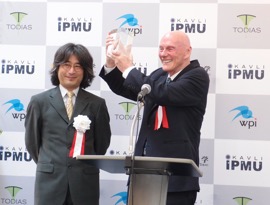 The establishment of the Kavli IPMU was one of the two last great events of Fred Kavli’s life. When you look at the picture of Fred and Hitoshi (Fig. 1), taken at the ceremony when the Kavli IPMU was announced in June 2012, you see in his face the enthusiasm he had for doing something in Japan that was going to be truly transformative from a scientific point of view. In this picture, he’s holding a gift commemorating that moment, and you can see that he cares enormously, just as we at The Kavli Foundation care enormously, about your success in pursuit of great questions in science. During our visit then, we could tell that great science was happening and Fred is expressing that joy.
The establishment of the Kavli IPMU was one of the two last great events of Fred Kavli’s life. When you look at the picture of Fred and Hitoshi (Fig. 1), taken at the ceremony when the Kavli IPMU was announced in June 2012, you see in his face the enthusiasm he had for doing something in Japan that was going to be truly transformative from a scientific point of view. In this picture, he’s holding a gift commemorating that moment, and you can see that he cares enormously, just as we at The Kavli Foundation care enormously, about your success in pursuit of great questions in science. During our visit then, we could tell that great science was happening and Fred is expressing that joy.
I remarked earlier about what I consider to be this extraordinarily innovative and imaginative approach of the WPI program that you have undertaken here in Japan. We don’t get to visit the prime minister or president of most countries, but when we came for the inauguration five years ago of the Kavli IPMU, we were graced by the willingness of the Prime Minister of Japan to visit with us, and he did. We had that visit in his office. It was Prime Minister Noda at the time.
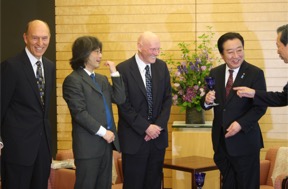 You can see here the four of us with a rather special wine glass (Fig. 2). The glass is a beautiful piece of art, with the blue bowl of the glass celebrating cosmology and the universe’s evolution from the big bang until now. In this picture, we’re enjoying a laugh together after the Prime Minister asked, “What's this glass about?”, and Hitoshi helped him out with the explanation. But more importantly, the presence of the Prime Minister was an expression by the leader of the government and people of Japan that science is important, and we were very appreciative that he met with us.
You can see here the four of us with a rather special wine glass (Fig. 2). The glass is a beautiful piece of art, with the blue bowl of the glass celebrating cosmology and the universe’s evolution from the big bang until now. In this picture, we’re enjoying a laugh together after the Prime Minister asked, “What's this glass about?”, and Hitoshi helped him out with the explanation. But more importantly, the presence of the Prime Minister was an expression by the leader of the government and people of Japan that science is important, and we were very appreciative that he met with us.
The celebration then, with people coming from around the world, just as the celebration today, reflects the character of what you have established here. In the United States, we have had many people come from Europe and Asia, including from Japan, to contribute to our science. This is now what you're doing. And just as it was very successful for us, I think it’s going to be extraordinarily successful for you.
Let me say a few words about The Kavli Foundation and its work. As you know, our mission is to support basic science for the benefit of humanity. It’s a core belief, you might say, that if you do the basic research, the results will contribute to humanity in ways that are unpredictable but certain to happen. I feel deeply confident in this statement. Why? Well, if you ask why over the past century-and-a-half the average life expectancy of people has increased from 45 to 85 years in so many countries, you can trace that fact to to just two things. One is achievements in engineering that have led to cleaner air, cleaner water, and addressed the sources of disease such as sanitation. Pasteur understood all that. The second is the contributions of basic science. These two developments have changed life around the world in ways never seen in human history. It has made life extraordinarily different, and here in Japan, where you have one of longest average life spans in the world, it’s because of science. That’s the simplest measure, life expectancy, of why supporting science is so important - it benefits everyone.
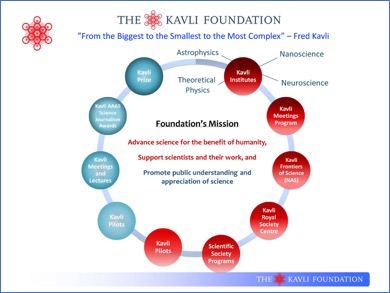 The program areas we support at a Foundation are shown in the graphic that is Fig. 3. The red circles represent our programs supporting basic science and accounts for more than two-thirds of everything we spend. By the way, the Kavli Institutes receive the bulk of this support.
The program areas we support at a Foundation are shown in the graphic that is Fig. 3. The red circles represent our programs supporting basic science and accounts for more than two-thirds of everything we spend. By the way, the Kavli Institutes receive the bulk of this support.
But we also care enormously about public understanding and public appreciation of science. Why? We in science want to do lots of things and to do our work, we need governments to invest generously in research. Governments, lest we forget, spend the people’s money. It follows that people – citizens – need to understand how basic research benefits humanity, why scientists work the way we do, and why it can take a long time to make from breakthrough discoveries to extraordinary benefits to society. This is the reason there are three Nobel prizes that were awarded across a span of more than 60 years, each associated with the basic scientific discoveries, that underlie the MRI’s everyone gets these days. Not one, not two, but three different Nobel prizes underpin the science of an MRI, the most widely used diagnostic today in medicine. The green circles in Fig. 3 are the programs we support in this important area.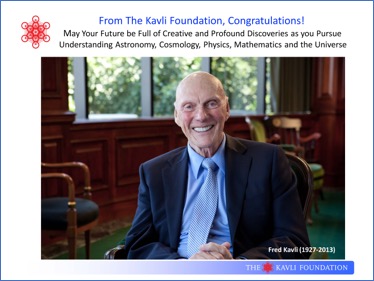
The year 2012 was the last year that Fred Kavli lived life to its fullest. In that year, as I said earlier, he came to Japan to celebrate the inauguration of your Kavli Institute – the Kavli IPMU. That September, he traveled to Oslo for the 2012 Kavli Prizes. Later that year, he became gravely ill and in 2013 he passed away at the age if 86, having lived a long and fruitful life.
So, on his behalf, and on behalf of The Kavli Foundation, we wish you a future full of creative activity and discoveries, a future that will advance science for the benefit of us all.
Thank you very much.
Remarks by Hitoshi Murayama, Director of the Kavli IPMU
Distinguished guests, friends, colleagues, ladies and gentlemen, thank you so much for the nice words given to us from distinguished speakers today and all of you being present at this ceremony which means so much to all of us.
Well, I was very impressed by this new interpretation of the name IPMU. I really like that. I always used to joke that IPMU stands for Informal Physicists and Mathematicians’ Utopia but “unusually happy” is better than utopia, so I really like that.
So, what a difference 10 years can make. You have seen the video. My hair used to be black, no longer. My belly used to be flat, no longer. This building didn’t exist back then but now we have this magnificent building for physicists, mathematicians, and astronomers to interact with. And there were no scientists on site 10 years ago. Now, they are two hundreds of them right here in this building today. What a difference 10 years can make.
When we started, I didn’t really believe that a world class international research center can be brought up from scratch. According to all the talks I listened today, apparently we made it, that’s fantastic.
Ten years ago, all the efforts we had to make to create this institute required new ideas and new systems, and President Gonokami emphasized this aspect. And I was kind of skeptical that all of these new ideas would stick with the university because they were so unusual and foreign compared to the traditional system of the university. But instead of alienating us, University of Tokyo embraced Kavli IPMU, which is remarkable in my mind, and I really appreciate all the effort done by the president, previous presidents, Professor Takigawa heading this campus as well. So this was a big change in the way the university operates, and according to Professor Ukawa program director, what we have done here apparently also changed the Japanese academia as a whole which is amazing, and something we had not anticipated 10 years ago.
Also 10 years ago, we didn’t think that this institute would continue to exist. The funding was guaranteed only for 10 years. I was very worried, 10 years later I will be standing here alone, empty, but now we see these many people celebrating this occasion which shows strong support from MEXT, president of the university, administration and Kavli Foundation, which also provided us very important resources to keep creating exciting research as well. So, this three-way support is really new in a Japanese system, if I understand correctly, and that enabled us to continue to exist and thrive beyond the initial 10 years. What a difference 10 years can make.
But we have to look beyond that. I specifically asked Mikhail Kapranov and Tom Melia to give a brief speech today because that’s the future of this institute. At the onset, at the time of the launch, a lot of great scientists joined this effort believing in the future but also somewhat on a risky path. They didn’t know quite what they were getting into but they were happy with this idea to create a new type of institute combining physics, mathematics, astronomy and many of them have left the institute since then and are doing great work elsewhere. But looking at Mikhail Kapranov and Tom Melia, they came here knowing what kind of institute this is. They already knew what was going on here and they appreciated that. They liked that. That’s why they came here. So, this is a new phase for the institute.
Ten years is a long time. It’s been a long time for me. But looking at the history of humanity, looking at 13.8 billion years of life of the universe, it’s such a blip of a moment and even just focusing on the history of science since Galileo and so on, you see the inscription of Galileo’s word on this pillar right here, ‘Universo scritto in lingua matematica’, Universe Is Written In the Language of Mathematics. In 400 years, 10 years is such a short period of time.
We are a startup company. We are like the beginning of Apple or Uber, the startup companies. We have a long way to go. So, 10 years is actually a very short period of time and there will be the next decade and the decade after and I really appreciate the long-term support from the Japanese government, University, and Kavli Foundation to at least think ahead about what may be happening in decades from now and that happens thanks to all of you here today.
All the support we get within the university, outside the university, from Japan and from the whole planet, maybe from extraterrestrial life as well and all the scientists, who created amazing research here at this institute and all the dedicated staff that supported the work by scientists, and as you saw in the video, they also led the system reform of the university.
This is a very unique combination. If we are missing any of them, we wouldn’t be here today and that’s the difference 10 years have made for this institute. Thank you so much for being here and I truly appreciate your support and presence today and thank you very much again.






